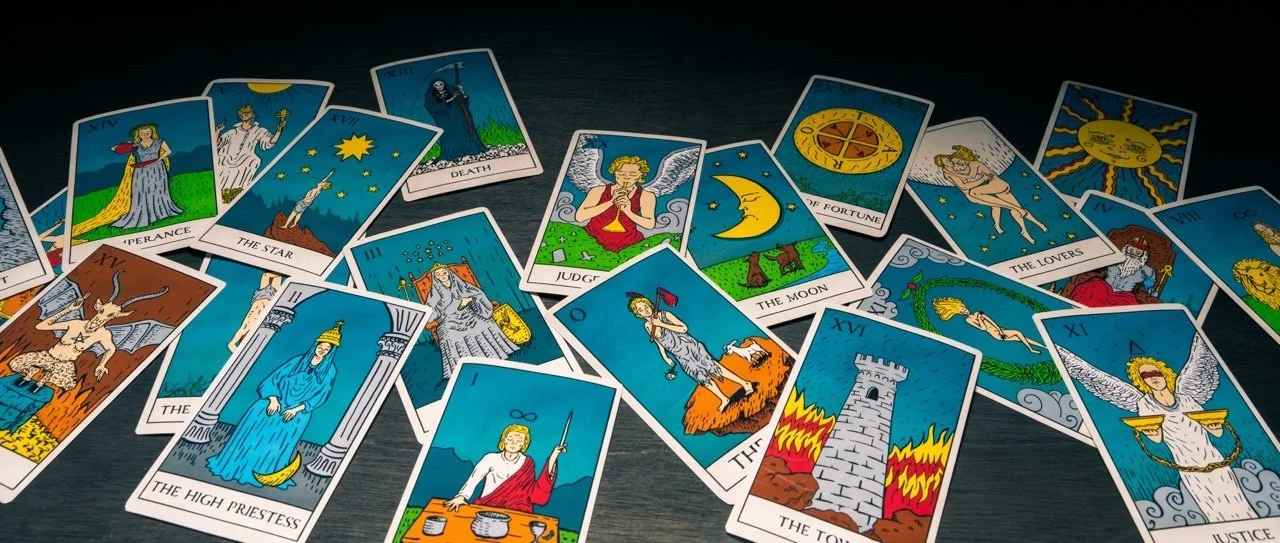Tarot 101: the Major Arcana
Hello, Lovely reader of The Tarot of These Times. In this post, I explain how the tarot is organized, including the major arcana, and who created the iconic tarot designs we all know.
Introduction to the Major and Minor arcana
The Major Arcana cards of the Rider-Waite-Smith tarot deck tradition. Image: Adobe Stock. TM U.S. Game Systems.
A typical 78-card tarot deck has two parts:
Major arcana (22 cards)
Minor arcana (56 ards)
The Major Arcana of the tarot is comprised of 22 cards (confusingly numbered 0-21). Each card represents a phase of a journey or cycle in life. This cycle repeats in different forms throughout our lives, including projects, situations, relationships, jobs, etc.
Many liken this cycle to The Hero’s Journey, popularized by Joseph Campbell in his 1949 book The Hero With a Thousand Faces. I like to think of the major arcana cards as representing life’s Really Big Moments.
For me, it’s like getting a glimpse into where the heck I am on life’s map. When feeling lost, so to speak, pulling one of these cards is a signpost akin to seeing a trail marker during a challenging hike.
Here is an oversimplified version of this dialog when I pull a Major Arcana card:
Me: Where the F am I??
Universe: You are here.
Me: Oh. Ok.
Tarot history
There is an air of mystery surrounding the origination of tarot, but the general consensus is that they were originally playing cards used in the wealthy classes of Italy in the 15th century. I recommend this article on tarot playing cards history from The Met: Before Fortune-Telling: The History and Structure of Tarot Cards.
Since then, artists have been reinventing the tarot for over 600 years. Here is a great overview from online magazine Artsy.
The most famous tarot deck is the iconic Rider-Waite Tarot deck. This deck is still in publication by U.S. Game Systems, which also owns the trademark and copyright for all 78 designs (more info here). Originally published in 1909, the illustrations were created by British female illustrator Pamela Colman Smith. Sadly, Smith did not receive much recognition or wealth for these illustrations during her lifetime.
Pamela Coleman Smith
The illustrator of the famous 1909 Rider-Waite tarot deck, as pictured in The Craftsman magazine, 1912.
Image: Pamela Colman Smith from the October 1912 issue of The Craftsman magazine. Source: WikiMedia Commons.
A departure from tradition
Importantly, I decided before starting to illustrate my deck that I would create completely new concepts and illustrations for my cards. Many decks re-draw the cards that Smith designed. While I respect the artists who go this route, I didn’t feel it was right for me.
So, moving forward, I will show examples of the cards from different tarot decks along with my own sketches. This will show you the differences in how I interpret each card.
Up Next
Did you know that the copyright process in the United States is managed by the Library of Congress? 📚
I didn’t either until I began registering my copyrights for illustrations. I my next post, I’ll share about the process of registering my sketches for copyright before publishing them on my website and to this blog.
This process is politically frought. Within the past few days, the White House fired both the director of the U.S. Copyright Office AND the Librarian of Congress, as reported here in the Washington Post.
More next week as I begin the process of interacting with this federal-level entity which is the only legal protection I have for my intellectual property as an artist and illustrator amid growing Ai concerns. (fun!)
The interior of the U.S. Library of Congress. Photo by Nick Jene, Adobe Stock.
Leave a comment below
I read every comment, and I love to hear from you!




